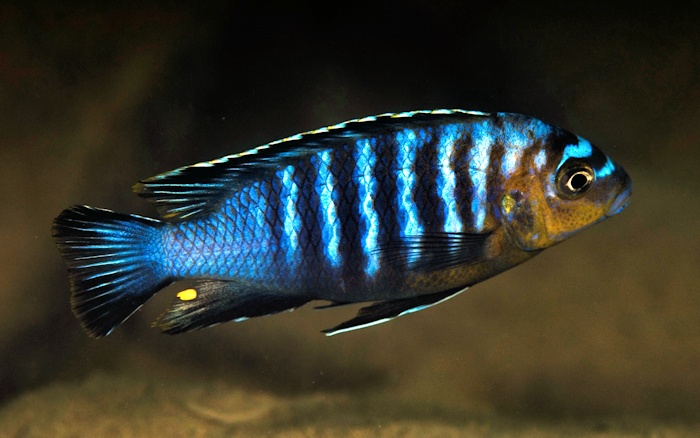
Maylandia flavifemina, a male photographed on the north side of Nankoma Island (Maleri Islands), 2008. Photo © by Larry Johnson, used by permission. |
Maylandia flavifemina (Konings & Stauffer, 2006)
by Michael K. Oliver, Ph.D.The above photograph, generously provided along with most of the other photos on this page by Larry Johnson, shows a male Maylandia flavifemina, one of the many members of the Maylandia zebra group. This species was first recognized as distinct from Pseudotropheus zebra itself (now correctly called Maylandia zebra) by Ribbink et al. (1983), who gave it the provisional name P. zebra 'black dorsal'. (The color photo of
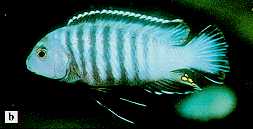
Maylandia flavifemina male at Maleri Island, labeled as Pseudotropheus zebra 'black dorsal' (from Ribbink et al., 1983, Plate 2b) |
The species remained without a formal scientific name until Konings & Stauffer (2006) named it Metriaclima flavifemina. However, notwithstanding the belief of these "Maylandia deniers," Metriaclima is the wrong generic name because it is only a junior synonym of the valid and earlier-named genus Maylandia. (No need to take my word for it. Dr. William Eschmeyer, the ichthyologist who literally wrote the book on all generic names of living fishes — and created the up-to-date Catalog of Fishes database of all fish genus and species names — authoritatively confirms that Maylandia is the valid name and that Metriaclima is a junior synonym. FishBase also knows that Maylandia is correct, not Metriaclima.) The correct name of this beautiful species is, therefore, Maylandia flavifemina.
Larry Johnson provided some interesting observations about M. flavifemina and his 2008 photos of it (at top and bottom of this page):
I first observed this fish around the "pinnacle" just off the eastern shore of Maleri Island back in 2002, back then this fish was not "officially" described I believe [true]. This fish is also found around the shores and reefs of Nankoma Island ... but I have not observed it around Nakantenga Island but I know it is supposed to be there. The pictures are from the North side of Nankoma Island (2008) where they were found quite a distance from shore in and around the rocky shallow submerged reefs. Depth in this area is not usually more than 25 feet (8 m). I have not observed this fish close to shore where the water is less than 3 m deep. The area is often visited by local sardine [usipa, Engraulicypris sardella] fishermen, who must stay at least 100 meters from shore as this Island is part of the Malawi National Parks. The bottom is uneven and I would doubt if any of the local mbuna were a collateral catch as these fisherman do their fishing at night when the mbuna are tight to the rocks sleeping.
More recently, Johnson sent me more photos of this species which he took in 2013 (see the trio of small photos below right, which can be enlarged). He gave an update:
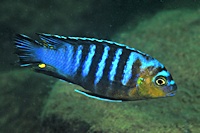
Maylandia flavifemina male, Maleri I. Photo © by Larry Johnson |
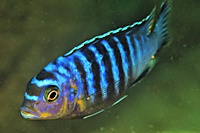
Mayl. flavifemina male, Maleri I. Photo © by Larry Johnson |
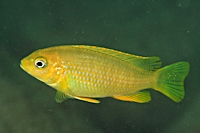
Mayl. flavifemina female, Maleri I. Photo © by Larry Johnson |
These were all taken at Maleri Island this year (2013). I have observed this fish at all 3 [Maleri] Islands Nakantenga, Maleri and Nankoma; also on the east side of Maleri there is a "boat propeller eating" rock just under the surface at certain times of the year and I have observed them there... but the last time I was there [2013] most fish were gone! This rock would lie just outside the 100m park boundary!
In addition to the three Maleri Islands, M. flavifemina also occurs at Thumbi Island West, at Chidunga Rocks, and at Namalenje Island according to information in the original description. Thus, all known localities lie within the southwest arm of Lake Malawi, except for Namalenje I. which is on the west shore just north of the two southern arms, at the lake's narrow "bottleneck" across from Makanjila Point.
Recognition characters: The original description (Konings & Stauffer, 2006) reports diagnostic features said to distinguish M. flavifemina from similar species. Males: The [largely] black anal fin and "black membranes in the caudal" [apparently only adjacent to the upper and lower edges of the fin] of M. flavifemina reportedly distinguish males of this species from all congeners except M. phaeos, as males of the remaining species have a blue or yellow anal fin and a caudal fin with the membranes yellow or blue. M. flavifemina has a shorter snout than M. phaeos (27.7-36.6% of head length, vs. 37.9-44.7%), as well as a shallower cheek depth although the reported ranges overlap in the two species.
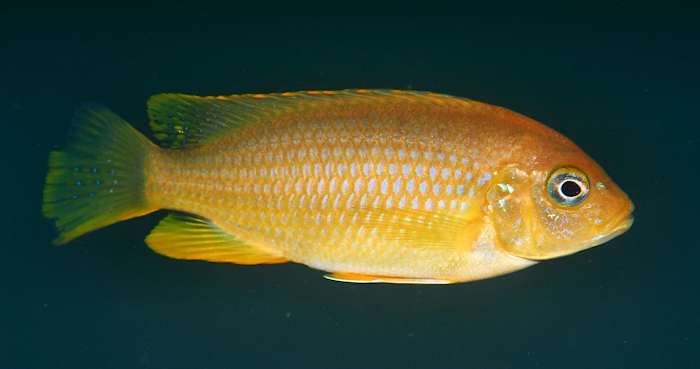
A female Maylandia flavifemina showing the yellow coloration for which this species is named. Photo taken at Nankoma Island in 2008, © by Larry Johnson; used with permission. |
Ecology: Ribbink and coauthors (1983: 162) already recorded most of what is known of the ecology of Maylandia flavifemina. They summarized it as "a lithophilous [rock-loving] fish of deep, sediment-rich habitats," stating that at the Maleri Islands it lives deeper than its relatives, from 5 to 27 meters (16-89 feet) with the latter depth being that of the deepest rocks there. It was most frequent "among broken medium-sized rocks" in 15-20 m of water but "also occurs over featureless slabs and occasionally over sand patches among rocks" and "sometimes extending a few metres onto sand." Konings & Stauffer (2006) extended the known depth range down to 40 m (130 feet).
Stomach contents (summarized by Ribbink et al. from 8 Nakantenga Island specimens) averaged "35% loose Aufwuchs, 27% benthic crustaceans, 26% plankton, 6% insects," and the remaining 6% the filamentous "algae" the authors referred to as "C1" and "C2" and which are thought to belong to the genera Cladophora (a green plant) and Calothrix (a bacterium).
Behavior: Males, noted Ribbink et al., "are aggressively territorial chasing both conspecifics and heterospecifics from their territories. Saucer-shaped nests are dug by those males which hold territories over sand. Females and other non-territorial members of this species are usually solitary." Konings and Stauffer observed further that "A territory normally consists of a space between the rocks, often with a sandy bottom. Males at the bottom of the reef usually burrow from beneath a rock to create a spawning cave. Females are often solitary or sometimes occur in small groups, rarely numbering more than three individuals."
